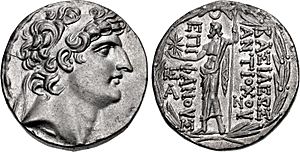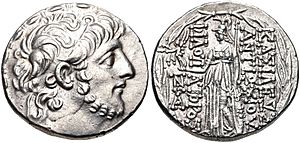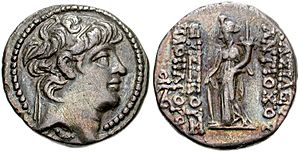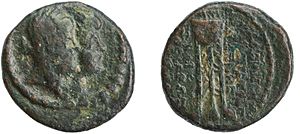Cleopatra Selene of Syria facts for kids
Quick facts for kids Cleopatra Selene |
|
|---|---|
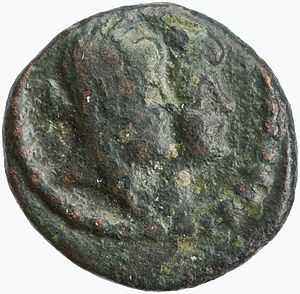
Jugate bronze coin depicting Cleopatra Selene in the foreground with her son Antiochus XIII in the background
|
|
| Queen consort of Egypt | |
| Tenure | 115–107 BC 107–102 BC |
| Queen consort of Syria | |
| Tenure | 102–96 BC 95 BC 95–92 BC |
| Queen regnant of Syria | |
| Reign | 82–69 BC (also regent for her co-monarch Antiochus XIII between 82 and 75 BC) |
| Predecessors | Antiochus XII Philip I |
| Successor | Antiochus XIII |
| Born | c. 135–130 BC |
| Died | 69 BC Seleucia (now Adıyaman, Turkey) |
| Spouse |
|
| Issue Detail |
Antiochus XIII |
| Dynasty | Ptolemaic (by birth) Seleucid (by marriage) |
| Father | Ptolemy VIII |
| Mother | Cleopatra III |
Cleopatra II Selene (born between 135 and 130 BC – died 69 BC) was a powerful queen in ancient times. She was a queen of Egypt from 115 to 102 BC. Later, she became a queen of Syria from 102 to 92 BC. Finally, she ruled Syria as a monarch from 82 to 69 BC.
Cleopatra Selene was the daughter of Ptolemy VIII and Cleopatra III of Egypt. Her mother, Cleopatra III, favored her. This made Cleopatra Selene an important part of her mother's political plans. In 115 BC, Cleopatra III made her son Ptolemy IX divorce his wife. She then chose Cleopatra Selene to be the new queen of Egypt.
However, Ptolemy IX and his mother had many disagreements. This led to Ptolemy IX being forced out of Egypt. Cleopatra Selene stayed behind. She likely then married her other brother, Ptolemy X, who became the new king.
For a long time, the Egyptian and Syrian royal families often married each other. This was to create alliances. In 102 BC, Cleopatra III decided to make an alliance with her nephew, Antiochus VIII of Syria. Cleopatra Selene was sent to Syria to marry him.
After Antiochus VIII was killed in 96 BC, Cleopatra Selene married his brother, Antiochus IX. She lost this husband in 95 BC. She then married for a final time to Antiochus IX's son, Antiochus X. He disappeared from records around 92 BC. Cleopatra Selene then went into hiding with her children.
Syria was divided among the sons of Antiochus VIII. Philip I ruled in the capital, Antioch. Antiochus XII ruled in Damascus. After Antiochus XII died, Cleopatra Selene declared her son, Antiochus XIII, king. She also seemed to rule alongside him.
However, the people of Antioch and Damascus were tired of civil wars. They invited foreign kings to rule them. Tigranes II of Armenia took Antioch. Aretas III of Nabataea took Damascus. Cleopatra Selene held onto some coastal towns. But in 69 BC, Tigranes II attacked her in Ptolemais. He captured the queen and later had her executed.
Contents
Understanding Cleopatra Selene's Family and Background
By the 2nd century BC, both the Seleucid Empire and the Ptolemaic Kingdom were getting weaker. They had many family fights and wars. The powerful Romans also started to get involved. To reduce fighting, the two royal families began to marry each other.
For example, Cleopatra I of Syria married Ptolemy V of Egypt in 193 BC. Her granddaughter, Cleopatra Thea, married three Syrian kings. These marriages helped Egypt cause problems in Syria. Syria was already divided, and Egypt supported one king against another.
Cleopatra Selene was born between 135 and 130 BC. Her parents were Ptolemy VIII and Cleopatra III. She had several brothers and sisters. These included Ptolemy IX, Ptolemy X, and Cleopatra IV.
Ancient writers called her Selene. The name "Selene" comes from the Greek moon goddess. It means "light." "Cleopatra" was a common royal name in her family. It means "famous in her father" or "renowned in her ancestry."
Cleopatra Selene was the second queen in Syria named Cleopatra. So, she is called "Cleopatra II Selene." This helps tell her apart from her aunt, Cleopatra I Thea.
Cleopatra Selene: Queen of Egypt
In ancient Egypt, it was sometimes acceptable for royal siblings to marry. The Ptolemy family did this to keep their power strong. In 116 BC, Ptolemy VIII died. His will said Cleopatra III could choose one of her sons to rule with her. She wanted Ptolemy X. But the people of Alexandria, the capital, wanted Ptolemy IX. So, she had to accept him.
Soon after, Cleopatra III forced Ptolemy IX to divorce his sister-wife, Cleopatra IV. This happened in 115 BC. Cleopatra Selene was her mother's favorite. So, she was chosen to be the new queen.
In 107 BC, Ptolemy IX and his mother had a big fight. Cleopatra III forced him to leave Egypt. He left his wife, Cleopatra Selene, and their children behind.
That same year, Cleopatra Selene likely married her younger brother, Ptolemy X. In 103 BC, Ptolemy IX was fighting in Judea. Cleopatra III worried about an alliance between Ptolemy IX and Antiochus IX of Syria. So, she sent troops to Syria.
Cleopatra III and Ptolemy X took the city of Ptolemais. The king, Ptolemy X, was shocked by his mother's actions. He left her. Cleopatra III then decided to marry Cleopatra Selene to Antiochus VIII of Syria. This was to get Antiochus VIII on her side. If Cleopatra Selene was married to Ptolemy X, her mother divorced her from him first.
Cleopatra Selene: Queen of Syria
Becoming a Queen Consort in Syria
Cleopatra Selene married Antiochus VIII around 102 BC. One historian believes Cleopatra Selene kept Ptolemais as her main base. We don't know much about her life with Antiochus VIII. They had no known children together. Antiochus VIII was killed in 96 BC. Cleopatra Selene was likely living in Antioch, the capital of Syria.
After her husband's death, Cleopatra Selene married Antiochus IX in 95 BC. It's not clear how this happened. She might have opened the city gates for him. Cleopatra Selene needed an ally to control the capital. Antiochus IX needed a wife and her influence. This marriage was probably not popular with Antiochus VIII's sons.
One of Antiochus VIII's sons, Seleucus VI, attacked Antiochus IX. Antiochus IX was defeated and killed. Seleucus VI then entered the capital. Cleopatra Selene likely fled before he arrived.
In 95/94 BC, Antiochus X, the son of Antiochus IX, declared himself king. He married Cleopatra Selene. It was unusual for a son to marry his stepmother. But it had happened before in the Seleucid family. This marriage was seen as scandalous by some. Antiochus X needed a queen and resources. Cleopatra Selene was in her forties and needed a powerful husband.
Antiochus X pushed Seleucus VI out of Antioch. He ruled northern Syria. The last record of Antiochus X is from 92 BC. He is thought to have died around this time.
Cleopatra Selene: Ruling Queen and Regent
We don't know where Cleopatra Selene was during this time. She likely hid with her children somewhere in the kingdom. She may have gone to Cilicia or Coele-Syria, perhaps to Ptolemais. She held this city until her death.
Antiochus XII, another son of Antiochus VIII, died in 83/82 BC. His throne in Damascus was empty. Cleopatra Selene then declared her son, Antiochus XIII, king.
Coins show Cleopatra Selene ruling alongside her son. She is shown in the front, and her name is written first. This suggests she was acting as a ruling queen. She controlled lands in Cilicia or Phoenicia. She definitely controlled Ptolemais. One historian wrote that "Selene ... ruled in Syria." This shows her continued power. Her children likely stayed in Cilicia for safety. This is why Antiochus XIII was called "Asiaticus."
Ruling in Damascus
The people of Damascus invited Aretas III, the King of the Nabataeans, to rule them. This was because they feared another king. The history of Damascus after Antiochus XII's death is not clear.
Some coins of Cleopatra Selene show her with Antiochus XIII. These coins may have been made in Damascus. If so, she might have ruled Damascus for a time.
- One idea is that Cleopatra Selene took Damascus after Antiochus XII died. But she might have been replaced by Aretas III later. Her coins were only bronze, meaning she lacked resources. This might explain why Aretas III was invited.
- Another idea is that Cleopatra Selene took control after Aretas III's rule ended. This could have happened after 80 BC.
Claiming the North
In the north, Philip I ruled until his death. After he died, Cleopatra Selene claimed the throne for her sons with Antiochus X. But the Syrians did not fully accept her claims. They were tired of civil wars. So, the people of Antioch invited Tigranes II of Armenia to rule Syria.
The exact year this happened is debated. Many scholars believe Philip I died in 83 BC. This would mean Tigranes II ruled for fourteen years, ending in 69 BC. However, some historians suggest Tigranes II invaded Syria later, in 74 BC. This would mean Philip I ruled until 75 BC. This would allow Cleopatra Selene and Antiochus XIII to claim the country for a while without opposition.
In 75 BC, Cleopatra Selene sent her two sons to Rome. They wanted to claim the throne of Egypt based on their mother's birthright. They brought a valuable candelabrum as a gift for the Roman Senate. The Senate refused their request for Egypt. But they recognized their right to the Syrian throne.
This shows that in 75 BC, Tigranes II was not yet in control of Syria. If he was, Antiochus XIII would have asked Rome for help to get Syria back. Also, Philip I could not have been alive.
Some historians suggest Cleopatra Selene controlled the south of Syria. Philip I ruled the north until 75 BC. When Philip I died, Cleopatra Selene's son was the strongest candidate for the throne. But Philip I's supporters opposed Cleopatra Selene. They offered the crown to Tigranes II. He then invaded Syria in 74 BC.
Downfall and Legacy
Cleopatra Selene's rule likely ended in 75 BC. Her son, Antiochus XIII, went to Rome, showing he was old enough to rule. Tigranes II's invasion happened around this time. He never controlled all of Syria. He took Damascus in 72 BC.
Cleopatra Selene resisted the Armenians in Ptolemais. Antiochus XIII probably hid in Cilicia. In 69 BC, Tigranes II attacked Ptolemais. The city fell. Tigranes II then imprisoned Cleopatra Selene in Seleucia. He later had her killed.
Historians believe Tigranes II killed her because she was so important. She was a valuable political figure. Tigranes II wanted to stop others from gaining power through her. Some see Cleopatra Selene as a pawn in political games. But she also became a clever player herself. She made decisions that benefited her.
Cleopatra Selene had a long career. She was the wife of three Syrian kings. She was also a mother to a king and a ruler in her own right. She was seen as a symbol of the Seleucid family's power.
Even after the Seleucid dynasty ended, their royal symbols were still important. Other eastern kings used Seleucid royal images to gain support. The Ptolemaic rulers of Egypt were related to the Seleucids. They were seen as their rightful successors. Cleopatra VII of Egypt named her own daughter Cleopatra Selene of Mauretania. This shows Cleopatra VII's attempt to claim the Seleucid succession rights.
Children of Cleopatra Selene
Cleopatra Selene had children with different husbands.
Children with Ptolemy IX
Some ancient writers say Cleopatra Selene and Ptolemy IX had two children. However, historians are not sure if these children lived long. In 103 BC, Cleopatra III sent her grandsons to the island of Kos for safety. If Cleopatra Selene's children existed, they might have been among them.
Ptolemy XII, the father of Cleopatra VII, was a son of Ptolemy IX. His mother's identity is not clear. Some historians believe Ptolemy XII's mother was Cleopatra IV. This would make him illegitimate because of his parents' marriage. If so, Cleopatra Selene would have been his official mother, not his biological one.
Cleopatra Berenice (Berenice III) might have been a daughter of Cleopatra Selene. But Cleopatra IV is also a possibility. Historians generally believe Berenice III was a legitimate child. This makes it more likely she was Cleopatra Selene's daughter.
Children with Ptolemy X
Ptolemy XI, a son of Ptolemy X, might have been Cleopatra Selene's child. His legitimacy was never questioned. If Ptolemy XI and Berenice III were both Cleopatra Selene's children, they would have been full siblings. However, we cannot confirm Cleopatra Selene was Ptolemy XI's mother.
Children with Antiochus X
It is hard to know exactly how many children Cleopatra Selene had with Antiochus X. One ancient writer said she had two sons, one named Antiochus. She might have had a daughter too.
- Antiochus XIII: This son is the Antiochus mentioned by the ancient writer. On coins where he rules alone, he is called Antiochus Philadelphos ("brother-loving"). But on coins with his mother, he is called Antiochus Philometor ("mother-loving"). This means Antiochus XIII used both titles.
- Seleucus Kybiosaktes: This is believed to be Cleopatra Selene's second son. He appeared in Egypt around 58 BC. He married Berenice IV of Egypt. However, ancient sources do not directly connect him to Cleopatra Selene. This is still a theory.
- Seleucus VII: In 2002, a coin was found showing Cleopatra Selene and a co-ruler. Some scholars read the ruler's name as Seleucus Philometor. They identified him as Cleopatra Selene's unnamed son. This ruler was called Seleucus VII. However, other historians disagree with this reading.
See also
 In Spanish: Cleopatra Selene I para niños
In Spanish: Cleopatra Selene I para niños



